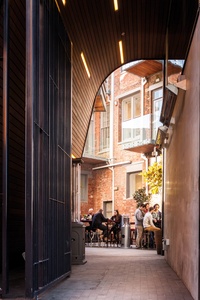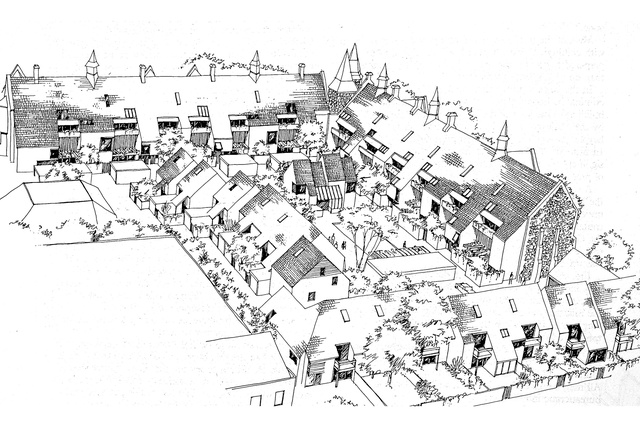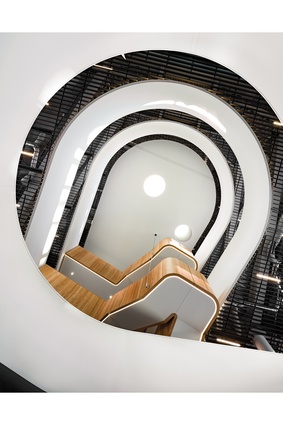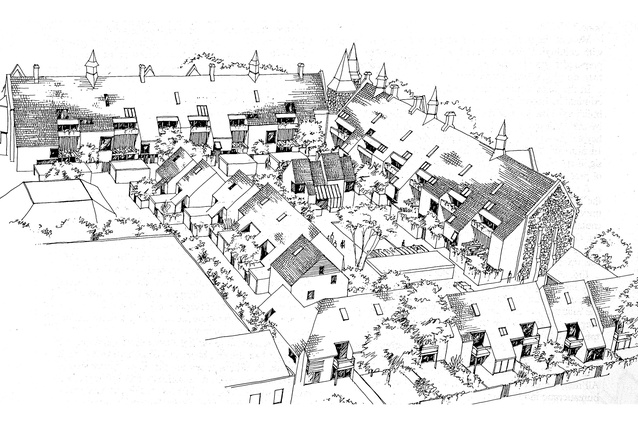Sheppard & Rout Architects Vol 1 1982–2021
Architectural books are a bit like buildings. There’s magic inside and much ado in their making. There are, of course, rewards in all the reading and writing, as that English teacher no doubt foretold, but, equally, there’s homework to be found when architecturally moonlighting a book.
It is hard to be hands off when you are the main characters and, with architects being nocturnally busy with the day job, building literary adventures as well as everything else requires some endeavour. There’s a whole new cast of characters to plot a course amongst. Add to the publishers, publicists and proofreaders, teams of graphic artists, distributors and editors, not to mention accountants and the inevitability of a book-length practical completion list.

Bigger questions follow, though, for just as buildings vary so, too, do architectural monographs. Are you building a Brittanica-esque set of volumes or a shorter story detailing a single building? Is this current or more of an autobiographical greatest hits? There’s a fit to be found amongst options of tome and whimsy, local and international, between the anthologies of coffee and cake or a choice of something stronger. Check the word count because the questions extend outwards. Are you hardbacking freight and strength, or softbacking something less durable but lighter in its footprint? To architects, writer’s block might not be stranger than fiction; it might simply be friction. Much ado about anything takes time. Think of those piles of half-read books cluttering your bedside or sitting-room table. Is there real estate in my bookcase for all this?
Yet recording things is important; it’s the way we collectively learn. As oral communications have become written and then visual, laying architectural stories out remains no less important. The shortening of information into increasingly small bites doesn’t seem to match the increasing byte size for value when it comes to architects narrating their adventures. The whats, hows and whys of architecture are generally hard to find in fast-ticking visuals and, while most architects now stream, few find opportunity to actually present work. So, amongst the braveries to building a book, it surprises that not more practices take on the challenge of printing out what they’ve been up to.
Architecturally, becoming “well-favoured” comes with much skill and hard work and at least a little “gift of fortune” as William Shakespeare puts it. Yet, consider, too, the call of the literary for, as Shakespeare follows, “but to write and read comes by nature”.1 We are, after all, part of the great generalist profession and architecture is a much-ado-about-everything type of calling.

It is into this literary narrative that editor David Sheppard and the team at Sheppard & Rout Architects find time to chronicle what they’ve been up to: Sheppard & Rout Architects Vol 1 1982–2021, published by Christchurch’s Quentin Wilson Publishing. Bravo, homework complete! Forty years in the making and the voices of some much respected former, retired and current practitioners suggest there’s important schooling to be found inside. Correct. There’s much to learn from this Christchurch practice, whose offerings include not just highly decorated buildings, but practice and personal contributions to the architectural profession that span from the protagonist to the presidential.

Their work reaches from the small to urban large, from neighbourly to international but, notably, starts with local context. A quick jump into the forwards sets up the where-froms in their first four decades of practice. The generous time frame is important for, as art historian Ian Lochhead writes: “Implicitly we are asked to consider what role Sheppard & Rout have played in this phase of our architectural history”. The monograph set up here surveys a long list of practice projects to connect into a wider commentary of the ways in which architecture in Aotearoa New Zealand has developed. It is from here we might project forward to the where-tos.
S&R has racked up a large number of commissions so, understandably, not all of their some two-and-a-half-thousand buildings are collated. But, there are too many buildings included for me to count, each succinctly catalogued into typologies to highlight the enormous variety in their work: Residential, Apartments & Townhouses, Urban Design & Master-Planning, Commercial & Hospitality, Public, Interiors, International and Health & Education. There is a lot to traverse and not many building functions that the practice hasn’t worked. Sheppard’s design summation of commonalities between their buildings being found in “forms that are simply modelled, crisp and robust, and which relate harmoniously in their landscape or urban setting” begins to aesthetically tie the many projects together.

But it is the collection of biographical accounts from key players within the practice that works to direct the notable architectural contributions and listing of buildings that follow. There’s a reflective approach which comes with experience. With the buildings spanning four decades, you can well imagine the cultural, fashion, political and landscape changes to be navigated. There’s plenty to place, and the narration highlights not just the importance of people within the life, work and durability of a practice but, also, of cities: most notably S&R’s home town, Christchurch.
Experience remains vital in navigating shifting grounds like those after the Canterbury earthquakes. Individual and shared philosophies towards the rebuild help those of us further away to draw lessons to a broader context. Jasper Van der Lingen expertly talks heritage, timber construction and open laneways in the rebuild, Tim Dagg to the importance of local environments. The newer crop of Matt Gutsell, Joff Kennedy, Steven Orr and Melissa Rogers look to the future of practice and place. Yet, it is the drawing of the practice philosophy backwards to its formation where this monograph and practice set its chronology: notably, from its two founding partners, David Sheppard and Jonty Rout.

Rout died in 2003 and his account, drawn from an interview with Morrin Rout, talks to his overseas experience, the trials of early practice, eventual embassy work and S&R’s strong lineage in housing, which continues today. Sheppard similarly cites his own international experience as providing “a strong ongoing influence on his [and we follow to S&R’s] architectural practice”. Between 1967 and 1975, Sheppard travelled, studied and worked for American practices on large urban environments. The account takes us from Greyhound buses to architecture and city planning at Penn State and, ultimately, to big-world urban development planning and politics on both coasts of America and in London, the kind of which few architects from these parts get to tackle. Nixon gave way to Muldoon in 1975 when Sheppard returned home.
The two founding partners eventually pooled their combined know-how to establish Sheppard & Rout Architects in Christchurch in 1982. Their everything then follows. ‘Then’ is an important word in Sheppard & Rout Architects Vol 1 1982–2021, for it links the practice story. Four decades is not something many practices can diarise and marks more than a significant contribution. So, hats off to S&R for 40 years of practice, this chronicle surveying their practice to date, and for printing it out for everyone to learn from and enjoy. Some monographs take volumes and Ian Lochhead keenly notes their foray into architectural print is “clearly intended to be an evolving project”. Sounds like more ado homework to come.
Reference:
1 William Shakespeare, Much Ado About Nothing (1598–99), Act 3, sc. 3, l. 14.


















